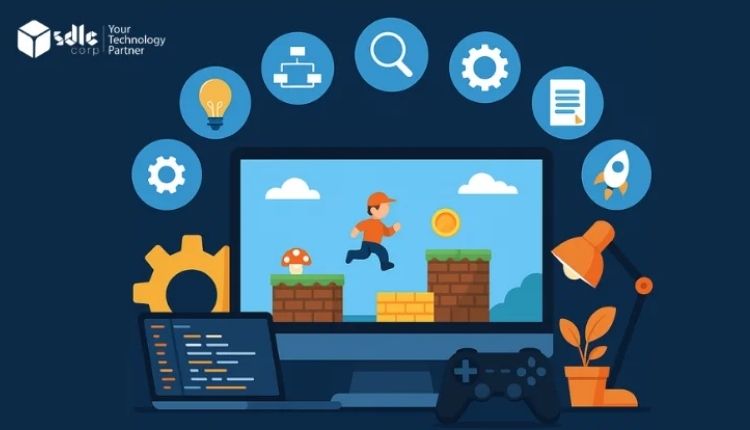Developing a video game used to mean building everything from scratch. Finding a team, buying licenses, rigging workstations, and so on. And don’t forget about crossing your fingers that the deadlines don’t turn into a disaster.
Flash forward to today. The market has changed drastically. With game development as a service (GaaS), turning an idea into a real game no longer requires building an entire studio from the ground up.
You can be anyone. An indie dreamer, a tech-savvy startup, a visionary publisher — GaaS is the way to go. It’s your pass to a whole world of on-demand expertise. Let’s go step by step on how GaaS can make every stage of the process easier, taking your game from concept to controller.
Understanding Game Development as a Service
Developing games as a service is also called GaaS for short. It’s a modern production model in which studios or individuals outsource any or all aspects of the game development process to third-party experts. You’ll basically have a whole development team that you can call on.
Those are the experts like N-iX Games that are ready to create your design, code, and art. They’ll be testing, publishing your game, or even doing your live ops.
Unlike traditional outsourcing, GaaS is built for agility. You can scale resources up or down if you need to change the project. You can switch between services as the game develops, but still keep full control over creative direction. The main thing is that all of it becomes accessible to you without needing to keep a massive in-house team.
It’s like a subscription to music streaming services. You get access to what you need, when you need it, without having to buy the whole orchestra.
Concept to Prototype: GaaS in the Early Stages
Every game starts with a spark. Maybe it’s a napkin drawing of a concept, or a scenario in your head that loops in your mind like a trailer. Maybe you thought up a fresh twist on an old mechanic. GaaS providers like N-iX Games can help shape that spark into an actual, market-feasible concept.
At this stage, you get access to creative consultants, market researchers, and prototype specialists. They will help you establish your game’s:
- Core loop
- Art style
- Genre fit
- User appeal
Instead of spending months building a team, you get instant access to experts who’ve been there and done that.
Need a functional prototype to court investors to test waters? GaaS lets you build an MVP (minimum viable product) in record time — without hemorrhaging your whole budget. It’s brainstorming and production, but with the safety net. You get to work with people who have plenty of experience in this field, but stay flexible about the way you cooperate.
Building the Core Game: Development and Production
With your vision nailed down, it’s time to flesh out the world. This is where GaaS truly shines.
You’re matched with committed developers, artists, animators, and project managers. Most of them have probably already released dozens (if not hundreds) of titles in the past. Do you need a Unity expert who knows mobile optimization? Or a multiplayer developer who’s built backend servers for 10,000+ users? No problem — you’ve got them all!
GaaS teams operate in Agile or Scrum methodologies. This means you get regular updates, sprint reviews, and clear milestones. You’re informed, every step of the way.
The best part? You can scale up or down at any time. Got unexpected funding and want to push towards more content? Hire a team of 3D artists and quest designers. Need to throttle back development in the midst of discussing publisher feedback? Dial things back without burning payroll.
It’s game development with momentum — and none of the headaches that usually come with it.
Testing, QA, and Polish
No one wants to launch a buggy mess. GaaS providers offer built-in quality assurance teams that test across platforms, devices, and cases. From stress testing servers to catching sneaky collision bugs, QA services make sure your game plays how it should.
Automated tools identify performance issues. Human testers focus on gameplay, flow, and user experience. You’ll get detailed bug reports, prioritized issue lists, and actionable feedback — all of that faster than you can say “hotfix.”
Polish is what separates a decent game from a great one. GaaS teams help you nail every detail, from UI animations to balancing combat. That final 10% that makes your game shine? They’ve got it covered.
Launch and Post-Launch Support
So, let’s say, the game is done. Now what?
There’s still a lot to do — creating a decent game was just half of the problem. Now you need to publish it on popular platforms, for starters. Luckily, GaaS companies can help you with the whole launch process. They’ll handle compliance, localization, store asset development, and even marketing services if you need them.
Once the game is live, the fun doesn’t stop there, either. Live service operation usually includes:
- patches;
- seasonal events;
- content drops;
- player feedback loops.
Need to patch a bug or start a holiday event? Your GaaS team is already on it.
This continuous loop of refinement and engagement turns your game into more than just a product. It becomes a gem that makes gamers keep wanting to come back each time for more.
GaaS From Start to Finish: Key Advantages
Let’s take a step back and look at the big picture. Why do studios, startups, and even big publishers use GaaS?
Here’s why it’s a game-changer (no pun intended):
- Top talent at your fingertips without the long hiring process
- Shorter production cycles with agile delivery
- Budget control and cost transparency with modular pricing
- Scale your team or reduce it instantly
- Less risk through milestone-based accountability
Maybe you’re building a mobile puzzler, a metaverse-ready MMO, or a VR escape room. Whatever the case, GaaS offers the infrastructure, creativity, and skill to get it done. All of it with less risk and more control.
Conclusion
Creating a game is a wild ride, but it doesn’t have to be overwhelming. With Game Development as a Service, that journey — from the first napkin sketch to global launch — becomes clearer, faster, and far more manageable.
You don’t need a massive studio. You need the right people, the right tools, and a partner who knows how to bring games to life. That’s what GaaS does.
So if you’re dreaming up the next big thing in games, maybe it’s time to ask yourself: Why build it alone, when you can build it smarter?






